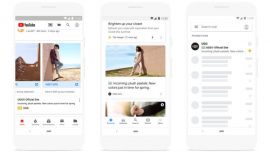Google is coming for Facebook budgets with Discovery ads, now available globally

Google introduced two big image-driven ad tests at its Google Marketing Live event last year. Gallery ads for Search campaigns didn’t make it and are set to shuffle off this summer, but Discovery ads have emerged from testing and are now available to all advertisers globally.
Discovery campaigns quietly rolled out last month, and Google made the news official Wednesday. Discovery ads are eligible to serve across the YouTube Home and Watch Next feeds, Discover feed on the Google Search app and in Gmail Promotion and Social tabs and open up new avenues for both Google and advertisers.
Treading lightly
If you’ve failed to notice ads in Discover feed yet, that’s because Google is treading very lightly here. The company says Discovery campaigns are delivering scale for advertisers, but it is being very cautious — particularly about ads in Discover feed.
There is currently just one ad slot — in position three — on the Discover feed. More ads are likely, but Jerry Dischler, VP/GM of Ads Platforms & Google Properties, in a phone interview Tuesday, said “we are holding the quality bar really high and only showing the ads that have the best image assets that we think are most relevant to users” in that context.
Google machine learning is used to determined when to serve a Discovery ad that will deliver the best results on the campaign objective, said Dischler, who noted results continue to improve.
Welcome to Google Ads, social media marketers
As we wrote last year, “Discovery campaigns take their cue from Facebook’s success at exactly this type of visually impactful, native ad format targeted based on audience data rather than search intent.”
When Google introduced the Discovery campaign type last year, it called out that the Discover feed has more than 800,000 monthly users. Now, Google is rolling up usage across the YouTube, Discover and Gmail surfaces to claim a combined audience of 2.9 billion people. This approach to audience totals takes a page from Facebook, which started reporting usage across its “family of apps” last year. As it would happen, Facebook reported 2.99 billion monthly active people (MAP) as of March 31.
In other words, Google is saying it can offer reach on par with Facebook.
In case it wasn’t abundantly clear that Discovery ads are aimed at paid social dollars, Google spells it out. In one case study cited in today’s announcement, Deckers “repurposed high-quality images from social campaigns” for Discovery ads last holiday season. In another, Gareth Cleevely, VP head of paid search at iProspect, says, “We’ve seen them deliver positive performance further down the funnel with up to 48% lower cost-per-action compared to social ads.” And yet another, Phil Twigg, head of acquisition at MandM Direct, says, “We were able to quickly scale our social media campaigns to Discovery ads.”
It is the Discovery ads that come out of the social vernacular that tend to perform best, said Dischler. He noted that in evaluating ad creatives during testing, they’d know which ones were created by social teams, display teams and search teams. Those who are using or adapting ads starting from social assets, including high-quality images, have been most successful in using Discovery ads to “inspire users and generate demand,” he said. Advertisers are “now understanding the value of a more multi-faceted marketing strategy.”
Discovery campaigns aren’t just another effort by Google to move beyond search intent and deliver audience connections throughout the funnel, they give Google an avenue into working with social budgets and teams. Which team is ultimately responsible for Discovery campaigns will vary, but in many cases agencies and companies will have search, display and now social teams with a hand in Google Ads campaigns.
How to get started with Discovery campaigns

Discovery ads are set up in Discovery campaigns. There are two ad formats: Discovery carousel ads with multiple images and Discovery ads with a single image.
For image assets, you can have Google scan your website for images that meet the size requirements, upload images, or select stock images from a Shutterstock library. The key is to have eye-catching, high-quality images. Google’s creative guide for says, “Aspirational imagery and copy is crucial.”
As with responsive search ads (RSAs), Discovery ads serve combinations of headlines and descriptions automatically. Enter up to five headlines and and five descriptions.
Google will also show a weekly impression estimate based on your geographic targeting. Targeting the United States? The weekly impressions estimate is 3.3 billion.
You can let Google automatically choose the call to action text in your ads or choose from more than ten options such as “Apply Now,” “Contact Us,” “Download,” “Visit Site,” and “Shop Now.”
Discovery campaign ad groups should be organized your campaign by strategy or theme.
In addition to location, Discovery campaigns can be targeted by audience and/or demographic (age, gender, parental status and household income).
Note that as this is one of Google’s automated universal campaign types, smart bidding is required and Ad Rotation and Frequency capping are not available for this campaign type. Google also notes in its Discovery ads tips page that advertisers should “Choose an average daily budget at least 10 times the value of your target cost-per-action (CPA) bid and wait for at least 40 conversions before making changes to your campaign.”
This story first appeared on Search Engine Land.
The post Google is coming for Facebook budgets with Discovery ads, now available globally appeared first on Marketing Land.
From our sponsors: Google is coming for Facebook budgets with Discovery ads, now available globally




